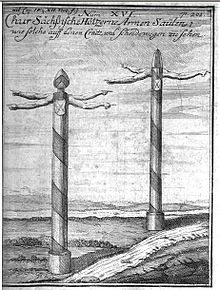Arm pillar
An arm column , also called an arm column , is a historical form of the signpost . These columns were made of wood and last z. Partly made of stone and showed the traveler the way for decades. Today there are only historical records and reconstructions of the wooden signposts or the remains of signposts with a stone.
Saxony
Already Elector Johann Georg III. von Sachsen ordered wooden pillars to be set up in 1682, which should replace the previous tree markings. In 1691, the erection of wooden arm pillars (then called arm pillars ) was ordered, which carried up to five labeled arms and the Saxon coat of arms with the course swords on a vertical pole . The wooden arms that serve as directional indicators were painted white and had black writing. The wooden shaft of the column was striped black and yellow. The wood for this was allowed to be taken from the electoral forests without payment. Another instruction on this is known from March 1, 1710 from the time of Elector Friedrich August I of Saxony, which also existed parallel to the Saxon post-mile pillars .
Since their wood rotten quickly due to permanent exposure to moisture, numerous pillars overturned a few years after they were erected and were unusable, so that stone pillars with wooden arms and, from the 19th century, signpost pillars made of regional stone material with chiseled location and distance information in leagues (1 hour = 4.531 km) as well as later with kilometer information . The basis for the independent erection of these wooden or stone signposts by the responsible municipalities was most recently the ordinances of the state government of 1820, which were valid until 1934.
Prussia
For Prussia there is a decree by King Friedrich I of 1704 for the erection of wooden arm signposts. On November 27, 1776, King Friedrich II of Prussia also ordered the erection of wooden signposts. The oldest verifiable wooden Prussian signpost was at the Kreuzhütte in Leimbach and was copied by the Heimatverein of the town of Mansfeld . Another replica is on Alte Hamburger Poststrasse in the Krämer Forest .
See also
- Post mileage
- Signpost
- Saxon postal mileage pillar
- Gallery of the Saxon post mile pillars
- Gallery of the royal Saxon milestones
- Gallery of signposts in Saxony
literature
- Carl Christian Schramm: Saxonia monumentis viarum illustrata ... , Wittenberg 1726.
- Setting of the arm pillars in the electoral forests , chancellery files, Saxon Main State Archive Dresden, inventory no. 10036, financial archive, Loc. 38276, Rep. 18, Gen. No. 0774, structure 12.0001.032. Forest surveys, forest borders and forest signs, 1791.
- Collective of authors (head of Eberhard Stimmel): Lexicon Kursächsische Postmeilensäulen , Transpress VEB Verlag for Transport, Berlin 1989, ISBN 3-344-00264-3 .
- Wolfgang Lotz (Ed.): Deutsche Postgeschichte , Berlin 1989.
- René Prokoph: Stone signpost pillars in the Saxon Switzerland district , series of publications by the Pirna City Museum , issue 10, Pirna 1997.
- Martin Scharfe: Wegzeiger , Jonas Verlag, Marburg 1998, ISBN 3-89445-230-7 .
- Siegfried Störzel: Old streets and signposts - The arm columns in Pappendorf , Striegistal-Bote September / October 2003
- Post pillars and milestones . Published by the research group Kursächsische Postmeilensäulen e. V. Dresden / Grillenburg (City of Tharandt). 3rd revised edition, Schütze-Engler-Weber Verlag GbR, Dresden 2007, ISBN 978-3-936203-09-7 .
Web links
- Arm pillar made of stone in the Hohwald
- Arm pillars in Pappendorf near Nossen
- Early forms of the signpost
- The historical development of the road network in Saxony
Individual evidence
- ↑ Arm pillars or signposts. Illustration of a sign indicating how such goods should be placed on the order of March 1, 1710 , Saxon Main State Archives Dresden, inventory no.12884, Karten und Risse, Amtshauptmannschaft Döbeln, no.108, p. 65, 1710
- ^ Ordinance of January 29, 1820, concerning the erection of signposts and place-name signs. In: Gesetzsammlung 1820, p. 7 ( slub-dresden.de ).
- ↑ Joachim Seyffart: On the way on old roads: From 1820 new signs point the way. In: Erzgebirgische Heimatblätter , issue 1/2015, page 3.







